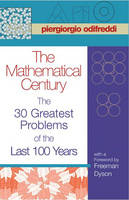
The Mathematical Century
Princeton University Press (Verlag)
9780691092942 (ISBN)
- Titel ist leider vergriffen;
keine Neuauflage - Artikel merken
The twentieth century was a time of unprecedented development in mathematics, as well as in all sciences: more theorems were proved and results found in a hundred years than in all of previous history. In "The Mathematical Century", Piergiorgio Odifreddi distills this unwieldy mass of knowledge into a fascinating and authoritative overview of the subject. He concentrates on thirty highlights of pure and applied mathematics. Each tells the story of an exciting problem, from its historical origins to its modern solution, in lively prose free of technical details. Odifreddi opens by discussing the four main philosophical foundations of mathematics of the nineteenth century and ends by describing the four most important open mathematical problems of the twenty-first century.In presenting the thirty problems at the heart of the book he devotes equal attention to pure and applied mathematics, with applications ranging from physics and computer science to biology and economics.
Special attention is dedicated to the famous '23 problems' outlined by David Hilbert in his address to the International Congress of Mathematicians in 1900 as a research program for the new century, and to the work of the winners of the Fields Medal, the equivalent of a Nobel prize in mathematics. This eminently readable book will be treasured not only by students and their teachers but also by all those who seek to make sense of the elusive macrocosm of twentieth-century mathematics.
Piergiorgio Odifreddi is Professor of Mathematical Logic at the University of Turin and has been a visiting professor at Cornell University for many years. He is the author of the textbook "Classical Recursion Theory". He is also a regular contributor to the Italian daily "La Repubblica". Freeman Dyson, Professor Emeritus of Physics at the Institute for Advanced Study, is the author of several books, including "Disturbing the Universe".
Foreword xi Acknowledgments xvii Introduction 1 CHAPTER 1: THE FOUNDATIONS 8 1.1. The 1920s: Sets 10 1.2. The 1940s: Structures 14 1.3. The 1960s: Categories 17 1.4. The 1980s: Functions 21 CHAPTER TWO: PURE MATHEMATICS 25 2.1. Mathematical Analysis: Lebesgue Measure (1902) 29 2.2. Algebra: Steinitz Classification of Fields (1910) 33 2.3. Topology: Brouwer's Fixed-Point Theorem (1910) 37 2.4. Number Theory: Gelfand Transcendental Numbers (1929) 39 2.5. Logic: Godel's Incompleteness Theorem (1931) 43 2.6. The Calculus of Variations: Douglas's Minimal Surfaces (1931) 47 2.7. Mathematical Analysis: Schwartz's Theory of Distributions (1945) 52 2.8. Differential Topology: Milnor's Exotic Structures (1956) 56 2.9. Model Theory: Robinson's Hyperreal Numbers (1961) 59 2.10. Set Theory: Cohen's Independence Theorem (1963) 63 2.11. Singularity Theory: Thom's Classification of Catastrophes (1964) 66 2.12. Algebra: Gorenstein's Classification of Finite Groups (1972) 71 2.13. Topology: Thurston's Classification of 3-Dimensional Surfaces (1982) 78 2.14. Number Theory: Wiles's Proof of Fermat's Last Theorem (1995) 82 2.15. Discrete Geometry: Hales's Solution of Kepler's Problem (1998) 87 CHAPTER THREE: APPLIED MATHEMATICS 92 3.1. Crystallography: Bieberbach's Symmetry Groups (1910) 98 3.2. Tensor Calculus: Einstein's General Theory of Relativity (1915) 104 3.3. Game Theory: Von Neumann's Minimax Theorem (1928) 108 3.4. Functional Analysis: Von Neumann's Axiomatization of Quantum Mechanics (1932) 112 3.5. Probability Theory: Kolmogorov's Axiomatization (1933) 116 3.6. Optimization Theory: Dantzig's Simplex Method (1947) 120 3.7. General Equilibrium Theory: The Arrow-Debreu Existence Theorem (1954) 122 3.8. The Theory of Formal Languages: Chomsky's Classification (1957) 125 3.9. Dynamical Systems Theory: The KAM Theorem (1962) 128 3.10. Knot Theory: Jones Invariants (1984) 132 CHAPTER FOUR: MATHEMATICS AND THE COMPUTER 139 4.1. The Theory of Algorithms: Turing's Characterization (1936) 145 4.2. Artificial Intelligence: Shannon's Analysis of the Game of Chess (1950) 148 4.3. Chaos Theory: Lorenz's Strange Attractor (1963) 151 4.4. Computer-Assisted Proofs: The Four-Color Theorem of Appel and Haken (1976) 154 4.5. Fractals: The Mandelbrot Set (1980) 159 CHAPTER FIVE: OPEN PROBLEMS 165 5.1. Arithmetic: The Perfect Numbers Problem (300 BC) 166 5.2. Complex Analysis: The Riemann Hypothesis (1859) 168 5.3. Algebraic Topology: The Poincare Conjecture (1904) 172 5.4. Complexity Theory: The P=NP Problem (1972) 176 Conclusion 181 References and Further Reading 187 Index 189
| Erscheint lt. Verlag | 28.3.2004 |
|---|---|
| Übersetzer | Arturo Sangalli |
| Vorwort | Freeman Dyson |
| Verlagsort | New Jersey |
| Sprache | englisch |
| Maße | 140 x 216 mm |
| Gewicht | 369 g |
| Themenwelt | Mathematik / Informatik ► Mathematik ► Allgemeines / Lexika |
| Mathematik / Informatik ► Mathematik ► Geschichte der Mathematik | |
| Mathematik / Informatik ► Mathematik ► Mathematische Spiele und Unterhaltung | |
| ISBN-13 | 9780691092942 / 9780691092942 |
| Zustand | Neuware |
| Informationen gemäß Produktsicherheitsverordnung (GPSR) | |
| Haben Sie eine Frage zum Produkt? |
aus dem Bereich


